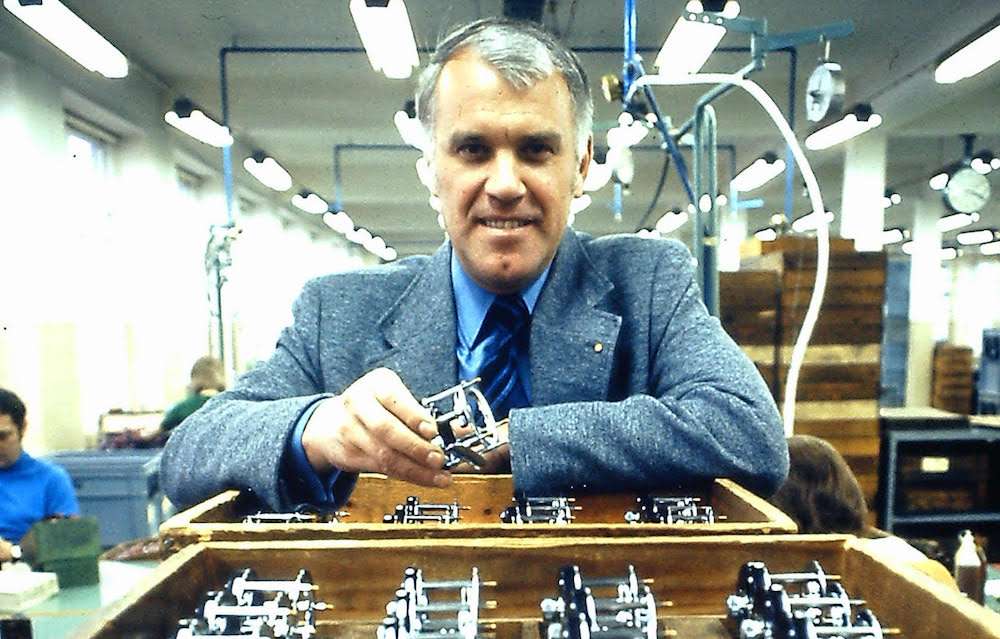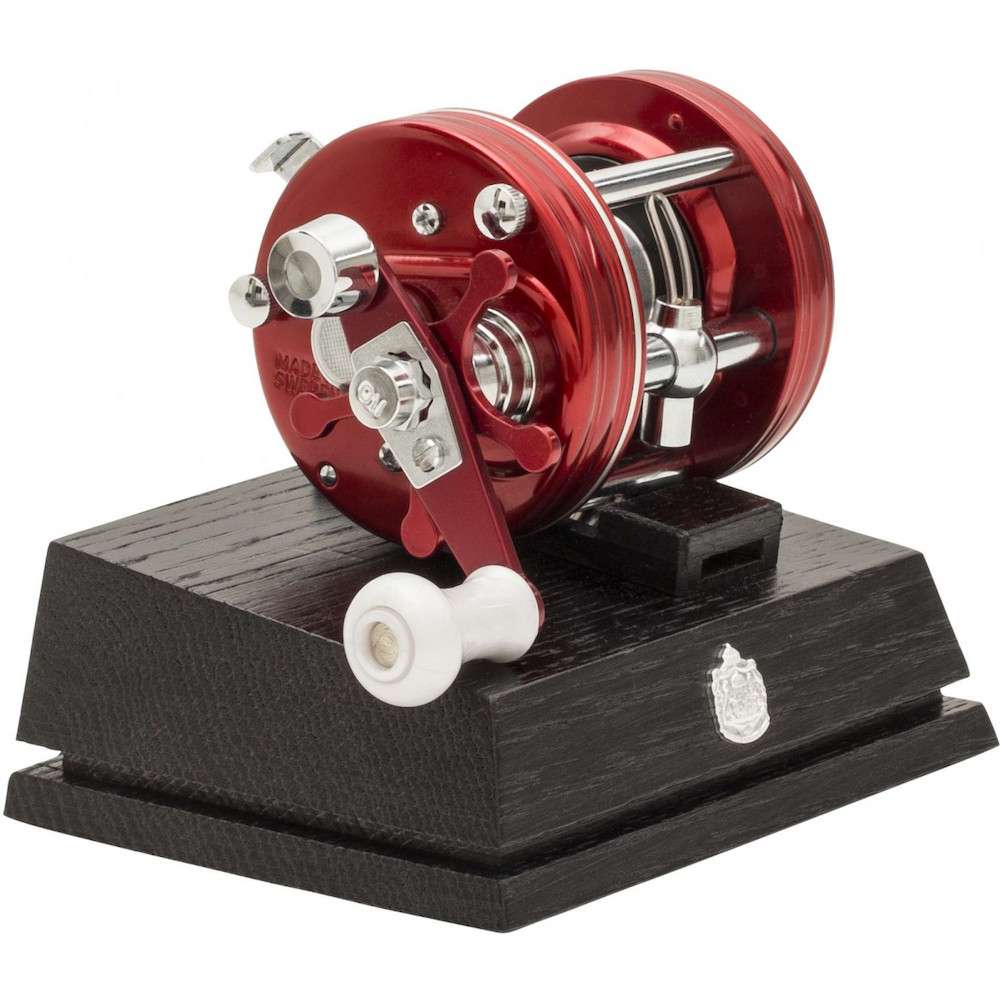
Len Borgström knows well that the often fickle nature of public opinion can be easily swayed by the perception of quality. In fact, the 87-year-old grandson of Abu Garcia founder, Carl August Borgström, recently shared an interesting historical nugget on how the Abu Ambassadeur 5000 — the acclaimed red round reel, which revolutionized baitcasters — actually ended up with its rosy complexion.
Now, the Abu Garcia story has been told many times, but for relevant background, here’s a respectful snapshot. In 1921, Carl Borgström founded AB Urfabriken (ABU), which translates to “AB Watch Factory,” by the Mörrum River in Svängsta, Sweden. Timepieces, telephone timers and taximeters were the original focus; but when World War II diminished their demand, Carl’s son Göte (Len’s father) refocused the company on fishing reels; the first of which was the ABU Record (1941).
The Garcia Corporation began importing the Swedish-made reels in the 1950s and a 1984 merger yielded the Abu-Garcia name. ABU debuted the Ambassadeur 5000 in Sweden in 1952 and introduced it to U.S. anglers two years later at the AFTMA Show at Conrad Hilton Hotel in Chicago. Suffice it to say, the reel’s anodized aluminum frame, centrifugal brake and push-button free-spool design immediately captivated the fishing world.
The choice
Getting back to the tale of reel color, when ABU showed Ambassadeur 5000 prototypes at a Stockholm consumer show; attendees voted on red, gold, black and green options. The latter two colors were most popular, but with Göte already sold on red, that’s the direction the company proceeded.
Having recently taken over the company’s export management, Len quickly realized that the color decision would have significant impacts beyond Scandinavian markets.
“The conservative Englishman said ‘There’s no way in hell you can sell a red fishing reel to British fishermen,” he said. “So, we made a black reel for this market, but we also had red reels [available in the U.K.]. The first year, it was 90 percent black and 10 percent red that were sold in England. Two years later, it was the other way around because they said, ‘If I buy the most expensive casting reel in the world and I walk down the river, I would like people to see that the red reel is so different from everything else.’
“They were proud of the fact that they paid that kind of money for a reel and didn’t mind that people saw it. That was not the intention; it was just the consequence.”
The company was most certainly intentional about building a reel that would out-perform its expectations.
“One reason for our success is that both I and my father were very keen fishermen,” Borgström said. “We did not let anything out on the market unless we had tested it ourselves for at least one year. Every reel was tested by us personally before it was put on the market.
“Sweden is an expensive country in which to manufacture; taxes are high and costs are high, but we had only one ambition. We knew we had to establish a Rolex philosophy — we had to be better than anybody else out there. So we worked constantly on improvements.”

A reel life
A true fishing industry icon, Borgström has collected a treasure trove of memorable moments from landing a 40-pound Norwegian salmon, to losing count of the giant Mexican bass caught with B.A.S.S. founder Ray Scott, to teaching the queen of Sweden how to fish. We’ll conclude with a couple more notable experiences:
Day of the Duke —After marlin fishing off Cabo San Lucas, Mexico, Borgström and his crew were cooling off at a waterfront restaurant when John Wayne’s boat, a converted U.S. Navy minesweeper named “Wild Goose” rolled into the marina. About 30 minutes later, when “The Duke” and his captain walked into the restaurant, Howard Ashby, then ABU-Garcia’s rod factory manager, who had provided gear to local boats, greeted them and asked the famous actor if he wanted to meet the guy who makes the Ambassadeur reel.
“John Wayne says: ‘What? Are you serious?’ and he grabbed a chair and moved up next to me and said ‘I can’t believe it; I must have a dozen of those!’” Borgström recalls. “As a result, we were invited for drinks aboard the Wild Goose. When we left, John Wayne said to Howard, ‘If Len is ever over here and my boat is available, it’s his.’”
The next year, Len returned to the Mexican peninsula; this time, to La Paz, on the Gulf of California side. When he and his group arrived, guess whose boat was waiting for them?
“The four of us and a crew of six on John Wayne’s boat went from La Paz, around the Peninsula to Cabo San Lucas,” Borgström said. “I slept in John Wayne’s cabin and we watched black-and-white John Wayne movies every night.”
The Essence — Ask Len Borgström his thoughts on taking kids fishing and he’ll tell you simply it’s the best thing you can do. Like most, he recognizes the sport’s propensity for steering young people away from less wholesome activities, but his thought runs deeper — back to his youth, actually.
“I have a picture that was taken in Iceland, while I was salmon fishing with my father,” he said. “The picture is just me sitting on a rock by the river. To me, that’s my best fishing picture. It’s no dead fish; it’s just me sitting there. I know that the salmon is out there and I’m sitting there waiting.
“In those moments, your mind is free and you know it’s between you and the salmon. It really doesn’t matter who wins. To me, that’s fishing. It’s not necessarily the biggest fish, or the most fish; it’s the fact that you know that the fish is there and it’s the challenge of getting it to take your lure.”
Borgström no longer has his first reel, a Record 2100, but he’d like to see someone organize a tournament in which anglers fish with their oldest Ambassadeur. Nostalgic as it sounds, he believes such an event would demonstrate what owners have known for years.
“I don’t know of anyone who has really worn out an Ambassadeur,” Borgstom said. “If the bushings on one of the original red reels, you could easily change them yourself without any special tools. You can’t wear out an Ambassadeur; you can wear it in.”
Enduring quality, endearing appeal — that defines the “current” of angling passion that flows through the Borgström legacy like the waters of the Mörrum.






